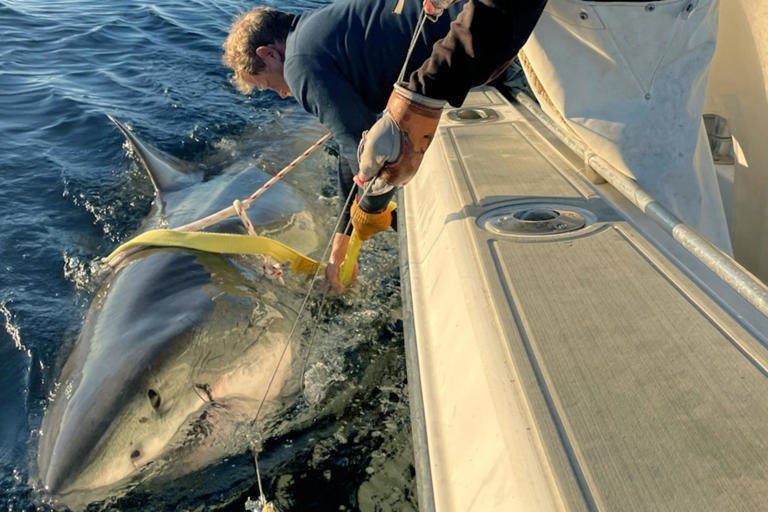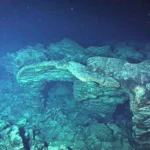The vast and mysterious depths of the Atlantic Ocean continue to reveal incredible marine life, and recently, researchers have been tracking a truly remarkable specimen.
The largest great white shark ever tagged by researchers in the Atlantic Ocean has made a significant appearance, surfacing off the coast of North Carolina as it undertakes its seasonal migration to cooler northern waters. This monumental shark, named Contender, represents a critical subject for marine biologists and oceanographers, offering invaluable insights into the behavior and movements of these apex predators.
The tracking of Contender began earlier this year, marking a pivotal moment in great white shark research. His re-emergence and the data collected from his journey provide a rare glimpse into the life of an exceptionally large individual of this magnificent species. The information gathered from Contender’s movements contributes significantly to a broader understanding of great white shark ecology, including their migratory patterns, habitat preferences, and the role they play in the marine ecosystem. This discovery not only excites the scientific community but also captivates the public, highlighting the incredible wonders that still exist within our oceans.
Contender: The Largest Tracked Great White
New data confirms Contender’s immense size, making him a record-breaking subject for oceanic research.
Initial Tagging and Remarkable Dimensions
The journey of Contender the great white shark as a tracked subject began in the waters off the coast of Florida. He was first successfully SPOT tagged on January 17 of this year. This initial tagging operation, a highly specialized and delicate procedure conducted by marine researchers, affixed a satellite-transmitting tag to the shark, allowing its movements to be monitored remotely. The SPOT (Smart Position or Temperature Transmitting) tag periodically sends signals to satellites when the shark surfaces, providing crucial location data.
Since that initial tagging, Contender has been located again by a team of dedicated oceanographers and researchers from OCEARCH, a non-profit organization renowned for its groundbreaking work in tracking and studying large marine animals. Upon this subsequent encounter and measurement, the sheer scale of Contender was confirmed.
Researchers measured him at an astonishing 1,653 pounds (approximately 750 kilograms) in weight. Furthermore, his length was recorded at an impressive 13 feet and 9 inches (approximately 4.19 meters). These dimensions solidify Contender’s status, making him the largest great white shark ever tagged by OCEARCH researchers in the Atlantic Ocean. This record-breaking size underscores the significance of tracking this individual, as it provides unique data points on the growth and physiological characteristics of exceptionally large great whites in this region.
OCEARCH’s Role in Shark Research
The successful tagging and ongoing tracking of Contender are a direct testament to the pioneering efforts of OCEARCH. This non-profit organization is at the forefront of providing open-source data on the movements of large marine animals, including great white sharks, tiger sharks, and other species.
Their methodology involves a unique research platform – a specialized vessel designed to safely lift sharks out of the water for brief periods, allowing scientists to conduct various studies, including tagging, tissue sampling, and measurement. This approach allows for detailed data collection that would be impossible with remote tagging methods alone.
OCEARCH’s mission extends beyond mere tracking. They aim to accelerate the ocean’s return to abundance by generating never-before-gained data on the ocean’s giants. The information collected from tagged sharks like Contender is made publicly available through their Global Shark Tracker, allowing not only scientists but also the general public to follow the movements of these animals in near real-time. This transparency fosters greater understanding and awareness of marine conservation issues.
The data helps researchers understand critical aspects of shark biology, such as their reproductive cycles, feeding patterns, and the habitats they utilize. The ongoing tracking of Contender provides invaluable insights into the life of a massive apex predator, contributing significantly to the global scientific community’s understanding of great white sharks in the Atlantic.
Migration Patterns: A Journey to Cooler Waters
Contender’s movements perfectly illustrate the seasonal migratory habits of great white sharks in the Atlantic.
Seasonal Shifts: From Warm to Cool
The recent location of Contender off the coast of North Carolina is entirely consistent with the well-established migratory patterns of great white sharks in the Atlantic Ocean. These formidable predators exhibit clear seasonal shifts in their geographical distribution. Great whites tend to migrate to cooler waters during the summer months.
This movement is driven by a combination of factors, including feeding opportunities, reproductive cycles, and thermal regulation. Cooler waters often provide richer feeding grounds for the large prey that constitutes a significant part of a great white’s diet, such as seals and larger fish.
Conversely, these sharks typically spend the winter months in warmer conditions. The warmer waters of the south provide a more comfortable environment, particularly for younger sharks, and may also be associated with breeding activities. This explains Contender’s extensive journey. His initial tagging in January off the coast of Florida placed him in the warmer wintering grounds.
His current presence off North Carolina indicates he is actively undertaking his northward migration as the seasons transition to summer. This movement pattern is a fundamental aspect of great white shark ecology, demonstrating their adaptability to different oceanic conditions and their pursuit of optimal environments for survival and reproduction.
Contender’s Extensive Journey: 1,870 Miles
Contender’s zigzagging movements along the US coast since his initial tagging in January provide a concrete example of this large-scale migration. His journey from the warmer waters off Florida to his current position near North Carolina encompasses a significant distance, totaling approximately 1,870 miles (about 3,000 kilometers) since January. This extensive travel highlights the incredible endurance and navigational capabilities of great white sharks.
The “zigzagging” nature of his path suggests that his migration is not simply a direct line but likely involves exploring various coastal areas, potentially searching for food sources or specific environmental conditions. Each “ping” from his SPOT tag, indicating a surfacing event, contributes to a detailed map of his movements, offering scientists unprecedented data on the exact routes taken by such a large individual.
This distance traveled is a testament to the energetic demands of these migrations and the vast territories that great white sharks utilize. Understanding these precise migratory routes is crucial for conservation efforts, as it helps identify critical habitats, potential interaction zones with human activities, and areas that may require enhanced protection during different times of the year. Contender’s journey is not just a scientific curiosity; it’s a vital piece of the puzzle in understanding and protecting these magnificent marine giants.
The Importance of Tracking Great Whites
Tracking individual sharks like Contender provides invaluable data for scientific research and conservation efforts.
Unlocking Behavioral Secrets
The ability to track individual great white sharks like Contender offers an unprecedented opportunity to unlock their behavioral secrets. Prior to advanced satellite tagging technologies, much of what was known about these elusive creatures was derived from anecdotal evidence or limited observations. Now, researchers can collect continuous, long-term data on their movements, diving patterns, and even environmental preferences. This allows scientists to:
- Map Migration Routes: Precisely identify the seasonal highways great whites use, revealing critical feeding, breeding, and birthing grounds.
- Understand Habitat Use: Determine which depths, water temperatures, and coastal areas they frequent, and how these preferences change with age, sex, and season.
- Study Foraging Strategies: Analyze movement patterns in relation to known prey concentrations, offering insights into their hunting behaviors.
- Assess Time at Surface vs. Depth: Understand how much time they spend near the surface versus in deeper waters, impacting their vulnerability to certain threats.
This detailed behavioral data is essential for developing effective conservation strategies. It moves beyond broad assumptions to provide specific, data-driven insights into what these animals need to survive and thrive. Contender, as the largest great white ever tracked in the Atlantic, offers particularly valuable data, as the behaviors of such large, mature individuals may differ significantly from smaller, younger sharks.
Informing Conservation Efforts
The data gathered from tracking projects like OCEARCH’s work with Contender is not merely for scientific curiosity; it is fundamentally critical for informing robust conservation efforts. Great white sharks, despite their apex predator status, face numerous threats, including overfishing (both targeted and bycatch), habitat degradation, and climate change impacts on their prey and environment. By understanding their movements and critical habitats, conservationists can:
- Identify Protected Areas: Advocate for the creation or expansion of marine protected areas that encompass key shark habitats, especially during vulnerable life stages like breeding or pupping.
- Mitigate Human-Shark Interactions: Understand where and when sharks are most likely to encounter human activities (like fishing or recreational swimming), leading to better public safety advisories and responsible management practices.
- Assess Population Health: Analyze movement patterns and habitat use to infer information about population size and health, identifying areas where populations may be struggling.
- Educate the Public: Use real-time tracking data to engage and educate the public about shark biology and their ecological importance, dispelling myths and fostering appreciation rather than fear.
The more we know about these magnificent creatures through individual tracking, the better equipped we are to make informed decisions that protect their future. Contender’s journey provides compelling evidence that ongoing research and public education are vital components of ensuring the long-term survival of great white sharks in the Atlantic and across the globe.
The Future of Shark Research
Advancements in tracking technology promise even deeper insights into the lives of these elusive marine giants.
Technological Innovations in Tracking
The field of marine biology is constantly evolving, driven by significant technological innovations in tracking capabilities. The SPOT tags used on Contender, while effective, are just one tool in a growing arsenal. Future shark research promises even deeper insights, thanks to advancements like:
- Acoustic Tags and Receivers: These tags emit acoustic signals detected by underwater receivers, providing highly detailed, fine-scale movement data within localized areas. This is crucial for understanding how sharks use specific habitats like reefs or coastal zones.
- Pop-up Satellite Archival Tags (PSATs): These tags record data on depth, temperature, and light levels for months or even years, then detach and float to the surface to transmit data to satellites. They provide detailed environmental profiles of a shark’s journey, even if it stays deep for extended periods.
- Accelerometers and Video Tags: These advanced tags capture data on a shark’s movement (speed, turns, feeding events) and even record short video clips, offering direct observational insights into behavior without direct human presence.
- Genetic and Isotope Analysis: Complementing tracking data, these techniques analyze tissue samples to understand diet, reproductive status, and population connectivity, providing a holistic view of shark ecology.
These combined technologies offer a multi-faceted approach to shark research, allowing scientists to piece together a much more complete picture of their lives, from broad migratory paths to intricate foraging behaviors. As these technologies become more refined and accessible, our understanding of great whites and other marine species will continue to grow exponentially.
Engaging the Public Through Science
Beyond the scientific community, the tracking of individual sharks like Contender has played a pivotal role in engaging the public through science. OCEARCH, in particular, has mastered the art of making complex scientific research accessible and exciting to a global audience. Their online Global Shark Tracker is a powerful tool that allows anyone with internet access to follow the real-time movements of tagged sharks. This direct, visual connection fosters:
- Increased Awareness: Millions of people who might not otherwise engage with marine science suddenly become interested in shark migration patterns and habitat use.
- Myth Busting: By showcasing sharks as active, migratory animals, it helps to dispel common misconceptions and fear-mongering narratives often perpetuated by media.
- Conservation Support: Personal connection to individual sharks (often given names like “Contender,” “Mary Lee,” etc.) can translate into greater public support for marine conservation policies and funding.
- Educational Opportunities: Teachers and students worldwide use the tracker as an educational resource, bringing marine biology and geography to life in classrooms.
This public engagement is critical for long-term conservation success. When the public understands and appreciates the ecological role of sharks, they are more likely to support protective measures and advocate for healthier oceans. Contender’s journey serves as a powerful testament to how scientific discovery, when shared effectively, can inspire widespread fascination and commitment to the natural world.
Contender’s Journey and Ocean Insights
The tracking of Contender, the largest great white shark ever tagged by OCEARCH in the Atlantic, marks a significant milestone in marine research. His remarkable size, measured at over 1,600 lbs and nearly 14 feet, provides unique data points for scientists. Contender’s journey, zigzagging from Florida to North Carolina over 1,870 miles since January, perfectly illustrates the seasonal migration patterns of great white sharks, moving from warmer wintering grounds to cooler summer waters.
This ongoing research, spearheaded by organizations like OCEARCH, is crucial for unlocking the behavioral secrets of these apex predators and, most importantly, for informing vital conservation efforts. By understanding their movements and habitat use, we can better protect these magnificent creatures. Contender’s journey not only provides invaluable scientific insights but also serves as a powerful reminder of the incredible marine life that inhabits our oceans, fostering public engagement and support for their preservation.








